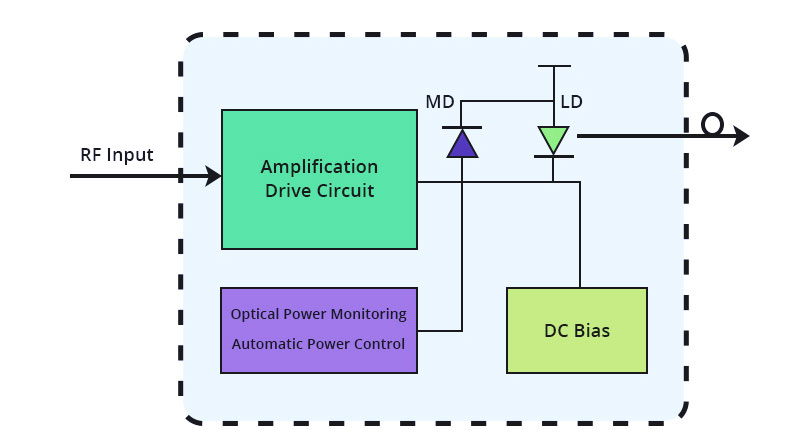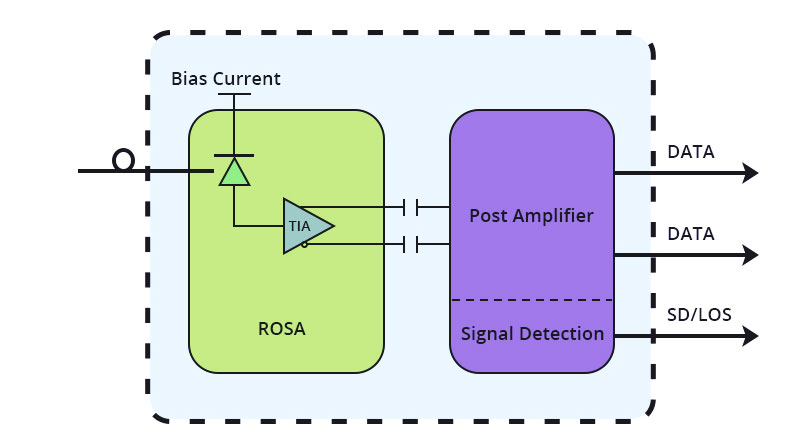The Internal Components and Structure of The Optical Transceiver
Optical modules are devices used to connect network devices, transmit and receive data between network devices, and can be used to convert optical and electrical signals. The optical module is a very important component in an optical communication system. This article will introduce you to the internal components and structure of the optical module.
Understanding the internal components of the optical module can give us further knowledge of the working principle of the optical module, we also notice that many articles are about the package type of the optical module, this article will fill the gap in the introduction of the internal components of the optical module.
The Main Internal Components of Optical Modules
Three main components make up the optical module: the external visible housing, the optoelectronic components, and the PCBA. Inside the metal housing of the optical transceiver, the internal components are generally connected together with sub-assemblies.
Optoelectronic Devices
Optoelectronic devices generally refer to components in optical modules used to detect and emit electromagnetic radiation. Optoelectronic devices are generally located in the visible and near-infrared (NIR) regions of the electromagnetic spectrum.
Optoelectronic devices detect and emit radiation by using the photoelectric effect of materials, it’s also called light-matter interactions. The theoretical support for this phenomenon is Einstein's proposal that it is light that is quantized and composed of photons rather than continuous waves.
As optoelectronic devices are the most important part of the optical module. Optical modules are designed for different applications and have different functions, there are two types of optoelectronic devices, that can achieve completely different functions in general transceivers: TOSA and ROSA. The optical transmitting part is called TOSA, the optical receiving part is called ROSA, combined the two together are called BOSA.

Figure 1: Optical Module Structure
What is TOSA?
The TOSA in the optical module is responsible for converting electrical signals into optical signals for optical transmitters. Transmit Optical Sub-Assembly (TOSA) components generally consist of optical isolators, monitoring photodiodes, LD driver circuits, thermistors, thermoelectric coolers, automatic temperature control circuits (ATC), and automatic power control circuits (APT). The most important of these is the Laser Diode.
The light source (semiconductor light-emitting diode or laser diode) is the core, the LD chip, the monitoring photodiode, and other components are packaged in a compact structure (TO coaxial package or butterfly package), and then constitute the TOSA. the most common light source is the LD laser diode. Compared with LD and LED, LD has lower power consumption, higher output, and coupling efficiency, LED has the advantages of low cost and long service life, and is only used for low-speed and short-distance transmission.

Figure 2: TOSA Structure
Common Laser Diode Types
Fabry-Perot (FP)
Corresponding fiber is single/multimode, which has high power, low-band line width (Spectral width), and can be used as a long-distance light source. FP is a resonant cavity structure compared to ordinary diodes. It provides the electricity to make the electrons inside the cavity due to the energy level jump and release the electrons, the end face of the cavity can be used as two end mirrors, causing photons to converge in the cavity, when the energy accumulates to a certain level will be emitted, so the critical current is needed.
Distributed Feedback-DFB
DFB laser is similar to FB laser in structure and photoelectric response characteristics, communication transmission needs to be above the critical current, and most of the wavelength band is around 1550nm, the difference with FP is that DFB adds a layer of grating along the outside of the common cavity, so that the laser light only allows a single wavelength light source to exist in the cavity, we call it Single Longitudinal Mode. Based on this feature, it is easier and more expensive to generate the specifically required light. The 40GBASE-LR4 optical module adopts a DFB transmitter that can reach up to 10km.
What is ROSA?
As we mentioned earlier ROSA is an optical receiver assembly, ROSA contains a photodiode (PD), an optical interface, metal (or plastic) housing, and an electrical interface. In high rate optical modules, PIN or ADP diodes, and TIAs are designed to be assembled in a sealed metal housing and these constitute an optical receiver assembly. The PD converts the optical signal into an electrical signal, which is later changed into a voltage signal by a Transimpedance Amplifier (TIA). The most important device of the receiver assembly ROSA is the photodetector, the photodetector can convert the light signal into an electrical signal through the photoelectric effect.
Some common photodetectors include PIN photodiodes and avalanche photodiodes (APD). APD photodetectors are characterized by high sensitivity, which uses the avalanche multiplier effect to enhance the photocurrent, which can be doubled up to the maximum, so APD receivers are more sensitive, and it can improve the sensitivity of PIN diodes by 6~10dB.

Figure 3: ROSA Structure
Common Photodiode Types
PIN-TIA
The PIN is the addition of an intrinsic semiconductor between the PN junctions. When PIN-TIA works, a dark current will lead to signal noise, this signal noise will have an impact on the work of PIN, as the temperature rises, the performance of photoelectric detection will become lower, resulting in a decrease in insensitivity.
APD-TIA
The electron avalanche inside the APD avalanche diode amplifies the transmitted weak photocurrent, which is also known as the multiplication effect. With high sensitivity before electrical amplification, the dark current in the APD avalanche photodiode is so small that the noise caused during transmission is negligible.
PIN and APD photodiodes both convert the received light from TOSA into an electrical signal, the difference between them is that PIN diodes are cheaper, and generally operate at the same voltage as other electronic devices. At a given optical power, it produces much fewer electrons than an APD, so receivers containing APDs are more sensitive, and the transmission distance of the optical module including APD is longer. For example, the 100GBASE-ER4 optical module adopts an APD receiver, it can reach up to 40km maximum transmission distance.
What is BOSA?
Bi-Directional Optical Sub-Assembly When the transceiver is made small enough, the TOSA and ROSA can be integrated into one transceiver during the coupling process. the BOSA assembly consists of TOSA and ROSA (LD and PD-TIA), WDM filters (0 degree and 45 degree); isolators; adapters, and pigtails. BOSA enables BiDi optical modules to support two wavelengths on one fiber by using bi-directional technology.
What is PCBA
The term PCBA stands for Printed Circuit Board Assembly. It is also known as PCB assembly or printed circuit assembly. PCB assembly modes are usually divided into surface mount technology (SMT) and dual in-line package (DIP). Typically, the entire process of PCB bare board is passed through the SMT upper layer section and then through DIP inserts. PCBAs can be used in transceivers because there are active and passive electronic components soldered to the printed circuit board. the main function of PCBAs is to secure integrated circuits and other electronic components as a way to ensure the high quality of electronic devices.
Three main components make we can see that PCBA is a complete component, there is a bare board is called PCB (Printed Circuit Board), the difference between PCB and PCBA is that the former is only a printed circuit board as an electrical connection carrier for electronic components, while PCBA contains PCB in addition to some other parts to be assembled together into a PCBA.
Conclusion
This article describes in detail the various internal components of optical modules including TOSA, ROSA, PCBA, and so on. The TOSA converts electrical signals into optical signals for the optical transmitter of the optical module, and the ROSA converts optical signals into electrical signals for the receiver of the optical module. If you want to know more about optical modules, please contact QSFPTEK via [email protected], QSFPTEK's technical support team can provide you with professional optical transceiver module related knowledge and information.










